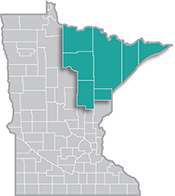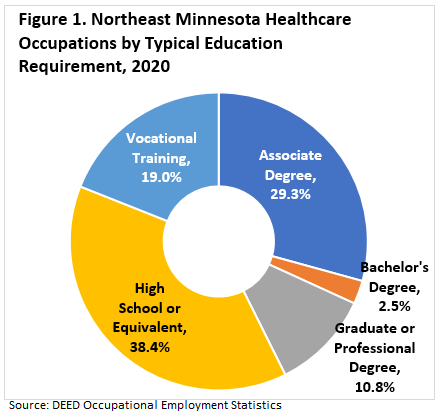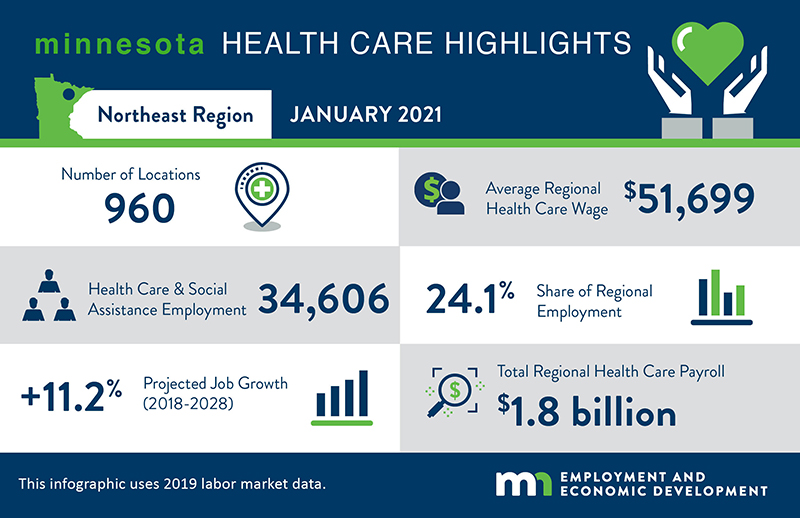 Home to the state's second-largest metro, the Northeast Region has a strong industrial sector, tied largely to the area's abundant natural resources.
Home to the state's second-largest metro, the Northeast Region has a strong industrial sector, tied largely to the area's abundant natural resources.
Most of the manufacturing base centers on mining and forest products industries. More than half of the sector's employment is in paper and machinery manufacturing.
Want the freshest data delivered by email? Subscribe to our regional newsletters.
1/7/2021 9:00:00 AM
Carson Gorecki
The Health Care industry in Northeast Minnesota is both growing and full of diverse employment opportunities. Health Care and Social Assistance employment accounted for over a quarter of all jobs in the region in the second quarter of 2020, the largest share of any sector. Up until the coronavirus pandemic, Health Care employment grew 5.1% in the past five years. And according to DEED’s employment projections and as seen on the infographic posted with this blog, the growth of the Health Care sector is expected to continue at an even greater rate of 11.2% through 2028.
Not all of these jobs require advanced degrees or education. In fact, nearly two out of every five health care jobs in Northeast Minnesota require only a high school diploma or equivalent and another one out of five typically require vocational training (see Figure 1). This means that there are many options available to those looking to enter the health care field without extensive training.
 According to DEED’s Occupations in Demand Tool, seven of the top 15, and 11 of the top 50 occupations with the highest demand are health care-related. Furthermore, many in-demand health care occupations typically require a high school diploma or postsecondary non-degree award – often a certificate. Short-term on-the-job training is typically an important component for many of these occupations.
According to DEED’s Occupations in Demand Tool, seven of the top 15, and 11 of the top 50 occupations with the highest demand are health care-related. Furthermore, many in-demand health care occupations typically require a high school diploma or postsecondary non-degree award – often a certificate. Short-term on-the-job training is typically an important component for many of these occupations.
Of the most in-demand health care occupations that don’t require a degree, Home Health and Personal Care Aides are in highest demand and are also expected to see the largest employment growth in the next decade. Nursing Assistants, Phlebotomists, and Licensed Practical and Licensed Vocational Nurses are also expected to outpace the average regional growth rate by large margins (see Table 1). Of the occupations with available projected growth rates, only Pharmacy Technicians is below the regional average, yet is still expected to see 432 openings from 2018-2028 due to retirements and other turnover.
Even with lower educational requirements, there are opportunities in health care occupations to earn wages near the regional median. Licensed Practical and Licensed Vocational Nurses, and Psychiatric Technicians have annual wages above the regional median of $39,582, and Pharmacy Technicians at $36,308 a year, earn wages just below (see Table 1).
| Job Title | 2020 Employment | Annual Median Wage | Planning Area Projected Growth Rate | Education Requirements |
|---|---|---|---|---|
| Registered Nurses | 5,100 | $66,583 | 5.7% | Associate degree |
| Home Health & Personal Care Aides | 6,540 | $27,244 | 23.6% | High school diploma or equivalent |
| Pharmacy Technicians | 550 | $36,308 | 1.1% | High school diploma or equivalent |
| Nurse Practitioners | 290 | $117,194 | 13.3% | Graduate or professional degree |
| Nursing Assistants | 2,630 | $33,249 | 4.1% | Postsecondary non-degree award |
| Pharmacy Aides | NA | $26,517 | NA | High school diploma or equivalent |
| Pharmacists | 470 | $145,283 | -4.9% | Graduate or professional degree |
| General Internal Medicine Physicians | NA | NA | NA | Graduate or professional degree |
| Phlebotomists | 180 | $34,234 | 20.2% | High school diploma or equivalent |
| Surgeons, Except Ophthalmologists | 60 | NA | 1.3% | Graduate or professional degree |
| Licensed Practical & Voc. Nurses | 990 | $45,331 | 7.3% | Postsecondary non-degree award |
| Psychiatric Technicians | 140 | $44,244 | NA | High school diploma or equivalent |
| Veterinary Technologists/Technicians | 90 | $36,328 | 15.4% | Associate degree |
| Nurse Anesthetists | 90 | $209,842 | 7.3% | Graduate or professional degree |
| Family Medicine Physicians | 300 | $207,982 | 6.6% | Graduate or professional degree |
| Source: Occupational Employment Statistics | ||||
Finally, local employers in the health care field are actively recruiting candidates for in-demand positions. For example, Essentia Health recently launched a program recruiting individuals for an Echo Technician program where they offer to pay for training if the candidate agrees to work for them for three years.
These and other programs work to make health care jobs more accessible for all, so that whatever your background, there is a path for you into a career in the health care field.

Contact Northeast Minnesota Labor Market Analyst Carson Gorecki at 218-302-8413.
Shawn Herhusky, Workforce Strategy Consultant for Northeast Minnesota